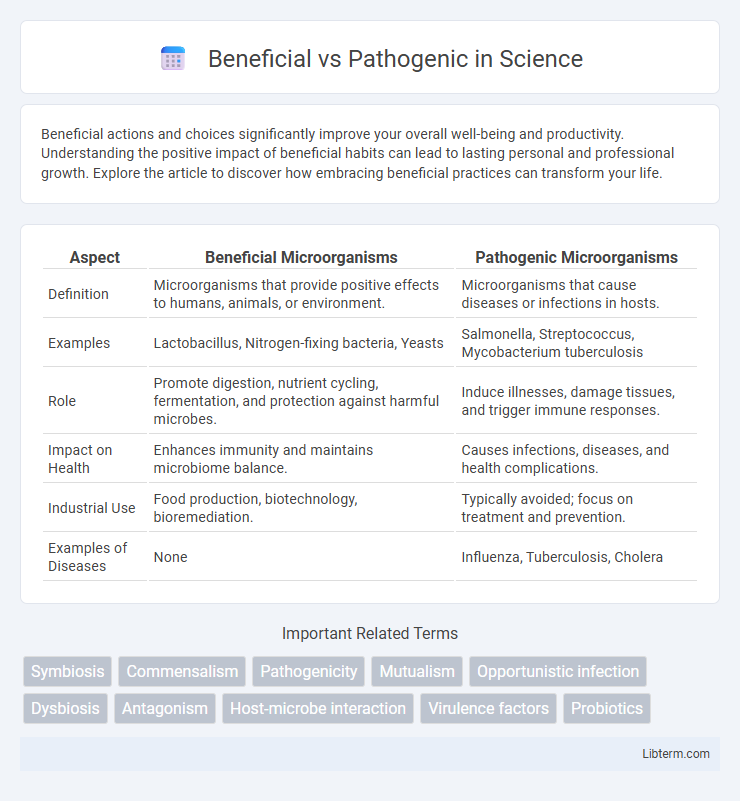Beneficial actions and choices significantly improve your overall well-being and productivity. Understanding the positive impact of beneficial habits can lead to lasting personal and professional growth. Explore the article to discover how embracing beneficial practices can transform your life.
Table of Comparison
| Aspect | Beneficial Microorganisms | Pathogenic Microorganisms |
|---|---|---|
| Definition | Microorganisms that provide positive effects to humans, animals, or environment. | Microorganisms that cause diseases or infections in hosts. |
| Examples | Lactobacillus, Nitrogen-fixing bacteria, Yeasts | Salmonella, Streptococcus, Mycobacterium tuberculosis |
| Role | Promote digestion, nutrient cycling, fermentation, and protection against harmful microbes. | Induce illnesses, damage tissues, and trigger immune responses. |
| Impact on Health | Enhances immunity and maintains microbiome balance. | Causes infections, diseases, and health complications. |
| Industrial Use | Food production, biotechnology, bioremediation. | Typically avoided; focus on treatment and prevention. |
| Examples of Diseases | None | Influenza, Tuberculosis, Cholera |
Introduction to Beneficial vs Pathogenic Organisms
Beneficial organisms play crucial roles in ecosystems by promoting nutrient cycling, enhancing soil fertility, and supporting plant growth through symbiotic relationships. Pathogenic organisms, in contrast, cause diseases by invading host tissues and disrupting normal biological functions, leading to negative impacts on health and productivity. Understanding the distinctions between beneficial and pathogenic microbes is essential for applications in agriculture, medicine, and environmental management.
Defining Beneficial Organisms: Roles and Examples
Beneficial organisms contribute positively to ecosystems and human health by promoting nutrient cycling, enhancing soil fertility, and supporting plant growth. Examples include nitrogen-fixing bacteria like Rhizobium, mycorrhizal fungi that improve water uptake in plants, and probiotic bacteria such as Lactobacillus that aid digestion in humans. These organisms play crucial roles in maintaining ecological balance and sustaining agricultural productivity.
Common Types of Pathogenic Agents
Pathogenic agents include bacteria like Streptococcus and Escherichia coli, viruses such as influenza and HIV, fungi including Candida species, and parasites like Plasmodium causing malaria. These agents invade host organisms, causing diseases that range from mild infections to life-threatening conditions. Understanding the mechanisms of pathogenicity helps in developing targeted treatments and preventive measures to combat infectious diseases.
Mechanisms of Beneficial Actions in Ecosystems
Beneficial microorganisms contribute to ecosystem stability by facilitating nutrient cycling through nitrogen fixation and organic matter decomposition, enhancing soil fertility and plant growth. They produce bioactive compounds that suppress pathogenic microbes, promoting plant health and reducing disease incidence. These mechanisms foster symbiotic relationships, improving biodiversity and ecosystem resilience against environmental stresses.
How Pathogens Cause Harm: Key Processes
Pathogens cause harm through mechanisms such as toxin production, tissue invasion, and immune system evasion, leading to cellular damage and inflammation. Bacterial toxins like exotoxins and endotoxins disrupt normal cell function, while viruses hijack host cellular machinery for replication, resulting in cell death. These processes trigger an immune response that often contributes to symptoms and tissue injury, distinguishing pathogenic effects from beneficial microbial interactions.
Interactions Between Beneficial and Pathogenic Microbes
Interactions between beneficial and pathogenic microbes significantly influence host health by modulating immune responses and competitive exclusion. Beneficial microbes produce antimicrobial compounds and compete for nutrients and adhesion sites, limiting pathogen colonization and infection severity. Pathogenic microbes may disrupt beneficial microbial communities through toxin production and immune evasion, tipping the balance toward disease states.
Impact on Human Health: Benefits vs Risks
Beneficial microorganisms in the human microbiome support digestion, enhance immune function, and prevent colonization by harmful pathogens, contributing to overall health and disease prevention. Pathogenic microbes cause infections, trigger inflammatory responses, and can lead to chronic illnesses or acute conditions, posing significant health risks. Balancing beneficial and pathogenic microbes is critical for maintaining homeostasis and reducing the incidence of microbial-related diseases.
Environmental Influence on Beneficial and Pathogenic Balance
Environmental factors such as temperature, pH, nutrient availability, and pollutant exposure critically influence the balance between beneficial and pathogenic microorganisms in ecosystems. Changes in these conditions can enhance the proliferation of pathogenic species or support beneficial microbes that promote biodegradation and nutrient cycling. Maintaining stable environmental conditions is essential to sustaining microbial communities that protect against disease and support ecological health.
Modern Applications: Harnessing Beneficial Organisms
Beneficial organisms play a critical role in modern biotechnology by enhancing agricultural productivity through biofertilizers and biopesticides, promoting sustainable farming practices. Pathogenic organisms, on the other hand, are targeted in medical and environmental applications using advanced techniques such as CRISPR gene editing and antimicrobial peptides to prevent disease outbreaks. Harnessing beneficial microorganisms in industries like pharmaceuticals, agriculture, and environmental management drives innovation while reducing reliance on chemical inputs.
Future Perspectives: Managing Pathogens and Promoting Beneficials
Emerging biotechnologies and microbiome engineering focus on selectively enhancing beneficial microbes to improve agricultural productivity and human health while suppressing pathogenic organisms. Advances in CRISPR and synthetic biology enable precise manipulation of microbial communities, facilitating targeted pathogen control without harming symbiotic species. Integration of real-time monitoring systems and AI-driven analytics promises optimized ecosystems, promoting sustainable practices that balance pathogen management and beneficial microorganism proliferation.
Beneficial Infographic

 libterm.com
libterm.com